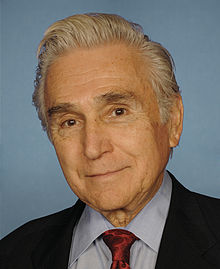This article has multiple issues. Please help improve it or discuss these issues on the talk page. (Learn how and when to remove these messages)
|
Maurice Hinchey | |
|---|---|
 | |
| Member of the U.S. House of Representatives from New York | |
| In office January 3, 1993 – January 3, 2013 | |
| Preceded by | Matthew F. McHugh |
| Succeeded by | Chris Gibson (redistricting) |
| Constituency | 26th district (1993–2003) 22nd district (2003–2013) |
| Member of the New York State Assembly from the 101st district | |
| In office January 1, 1975 – December 31, 1992 | |
| Preceded by | H. Clark Bell |
| Succeeded by | Kevin Cahill |
| Personal details | |
| Born | Maurice Dunlea Hinchey October 27, 1938 New York City, New York, U.S. |
| Died | November 22, 2017 (aged 79) Saugerties, New York, U.S. |
| Political party | Democratic |
| Spouse | Ilene Marder Hinchey |
| Children | 3, including Michelle |
| Alma mater | State University of New York at New Paltz |
| Military service | |
| Branch/service | United States Navy |
| Years of service | 1956–1959 |
Maurice Dunlea Hinchey (October 27, 1938 – November 22, 2017) was an American politician who served as a U.S. Representative from New York and was a member of the Democratic Party. He retired at the end of his term in January 2013 after 20 years in Congress.
He was born in New York City, and later moved to the Hudson Valley where he attended high school and college, Hinchey had previously represented part of the area in the New York State Assembly since 1975. As chair of that body's Environmental Conservation Committee, he took the lead in bringing environmental issues to the fore, particularly when he held hearings on the problems created by toxic waste disposal in the Love Canal neighborhood of Niagara Falls. In his later years in Congress, he opposed hydraulic fracturing to exploit the natural gas resources of the Marcellus Shale. Throughout his career, he was considered a political progressive for his liberal stands on other issues.